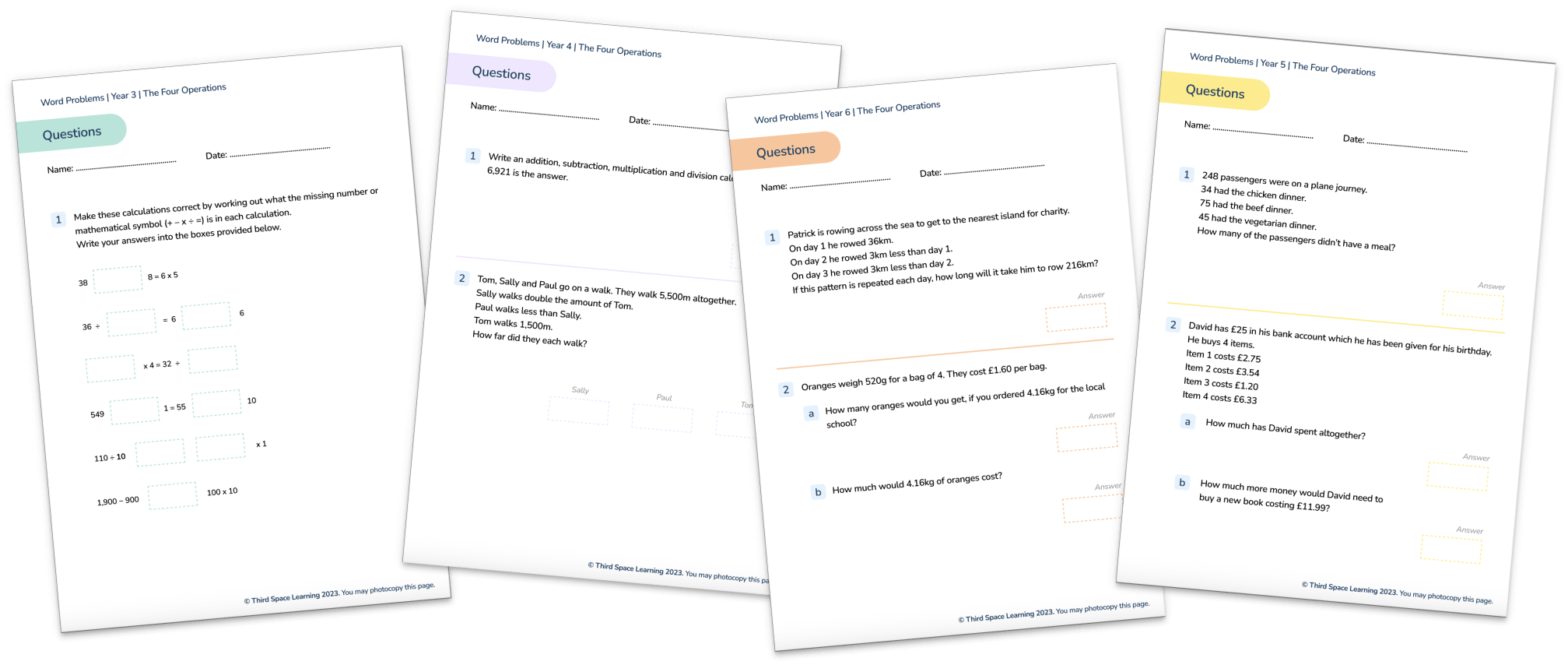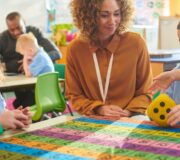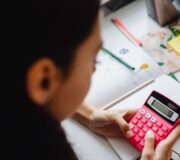25 Percentage Word Problems For Year 5 To Year 8 With Tips On Supporting Pupils’ Progress
Percentage word problems and the concept of calculating percentages first appears in Upper Key Stage 2. As pupils progress through school from KS2 to KS3, the skills they need to solve percentage word problems develop.
It is important to expose students to percentage word problems alongside any fluency work on percentages, to help them understand how percentages are used in real-life. To help you with this, we have put together a collection of 25 percentage word problems which can be used by pupils from Year 5 to Year 8. Don’t miss our downloadable word problems worksheet to develop these skills further!
- How pupils develop the necessary skills to solve percentage word problems
- Percentage word problems in the National curriculum
- Why are word problems important for children’s understanding of percentage
- How to teach solving percentage word problems in KS2 and early KS3
- Percentage word problems for Year 5
- Percentage word problems for year 6
- Percentage word problems for Key Stage 3
- More word problems resources
- Percentage word problems FAQs
All Kinds of Word Problems Four Operations
Download this free, printable pack of word problems covering all four operations; a great way to build students' problem solving skills.
Download Free Now!How pupils develop the necessary skills to solve percentage word problems
Initially, pupils are introduced to the per cent symbol (%) in Year 5. At this stage they are expected to understand that percent relates to ‘number of parts per hundred’ and should be able to solve problems requiring knowing percentage and decimal form equivalents of simple fractions.
As pupils progress into Year 6, they should be able to recall and use equivalences between simple fractions, mixed numbers, decimals and percentages. They also need to be able to solve word problems involving percentages of amounts and percentage increase and decrease.
Moving into Key Stage 3, pupils continue to build on the percentage work from primary, to solve percent problems, interpreting percentages and percentage change; expressing one quantity as a percentage of another; comparing two quantities using percentages and working with percentages greater than 100%.
Concrete resources (such as percentages cubes) and visual images (such as bar models) are important during the early stages of learning and understanding percentages. Word problems for year 3 and word problems for year 4 will often include visual aids. Upper Key Stage 2 teachers and pupils often have the mistaken belief that concrete resources are only for children who are struggling; however, with a new topic, such as percentages, it is important all children are initially introduced to the topic through the use of visual and concrete aids.
Percentage word problems in the National curriculum
Children are first introduced to percentage problems in Year 5. The National Curriculum expectations for percentages are that children will be able to:
Percentage in Year 5
- Recognise the percent symbol (5) and understand that per cent relates to ‘number of parts per hundred’.
- Write percentages as a fraction with a denominator 100, and in its decimal form.
- Solve problems which require knowing percentage and decimal equivalents of \frac{1}{2},\frac{1}{4},\frac{1}{5},\frac{2}{5},\frac{4}{5}, and fractions with a denominator of a multiple of 10 or 25.
Percentage in Year 6
- Recall and use equivalences between simple fractions, decimals and percentages, including in different contexts.
- Solve problems involving the calculation of percentages (for example, measures and such as 15% of 360) and use percentages for comparison.
Percentage in Key Stage 3
- Define percentage as ‘number of parts per hundred’
- Interpret percentages and percentage changes as a fraction or a decimal. Interpret these multiplicatively.
- Express one quantity as a percentage of another.
- Compare two quantities using percentages.
- Work with percentages greater than 100%.
- Interpret fractions and percentages as operators.
Percentage word problems will often include other skills, such as fraction word problems, multiplication word problems, addition word problems, subtraction word problems and division word problems.

Meet Skye, the voice-based AI tutor making maths success possible for every student.
Built by teachers and maths experts, Skye uses the same pedagogy, curriculum and lesson structure as our traditional tutoring.
But, with more flexibility and a lower cost, schools can scale online maths tutoring to support every student who needs it.
Watch Skye in actionWhy are word problems important for children’s understanding of percentage
Percentage word problems help children to develop their understanding of percentages and the different ways percentages are used in everyday life. Taken out of context, percentages can be quite an abstract concept, which some children can find quite difficult to understand.
Real-life problems involving percentages enable students to see how they will make use of this key skill outside the classroom.
How to teach solving percentage word problems in KS2 and early KS3
As with all word problems, students need to learn the skills required to solve percentage word problems. It’s important that children make sure they have read the questions carefully and thought about exactly what is being asked and whether they have fully understood this. They then need to identify what they will need to do to solve the problem and whether there are any concrete resources or pictorial representations which they can use to help them. Even pupils in Key Stage 3 can benefit from drawing a quick picture, to understand what a word problem is asking.
Third Space Learning’s AI maths tutoring programmes with Skye, the AI maths tutor, work to build students’ maths fluency and reasoning skills. Personalised to the needs of each individual student, our programmes fill gaps and build students’ confidence in maths.
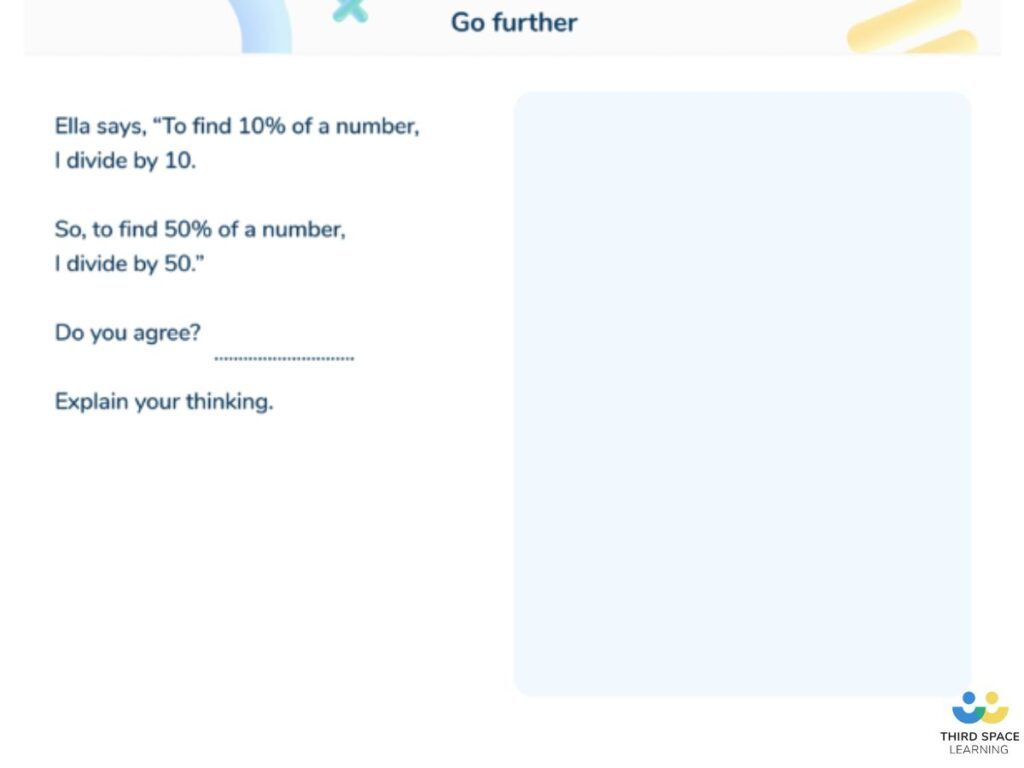
Percent word problem example:
A box of cupcakes sold by a bakery cost £3.40.
Due to the increased costs involved with running a bakery, the owner has decided to increase the price of everything sold by 20%.
How much will a box of cupcakes cost once the price has been increased?
How to solve step-by-step:
What do you already know?
– We know that the original price of a box of cupcakes is £3.40.
– If the price of the box is being increased by 20%, we need to work out how much 20% of £3.40 is.
– To do this, we need to work out how much 10% of £3.40 is. We therefore need to divide £3.40 by 10 = £0.34
– To calculate what 20% is, we need to multiply the £0.34 by 2 = £0.68
– Finally, we need to add the 20% (£0.68) onto the original price.
– £3.40 + £0.68 = £4.08
How can this be represented pictorially?
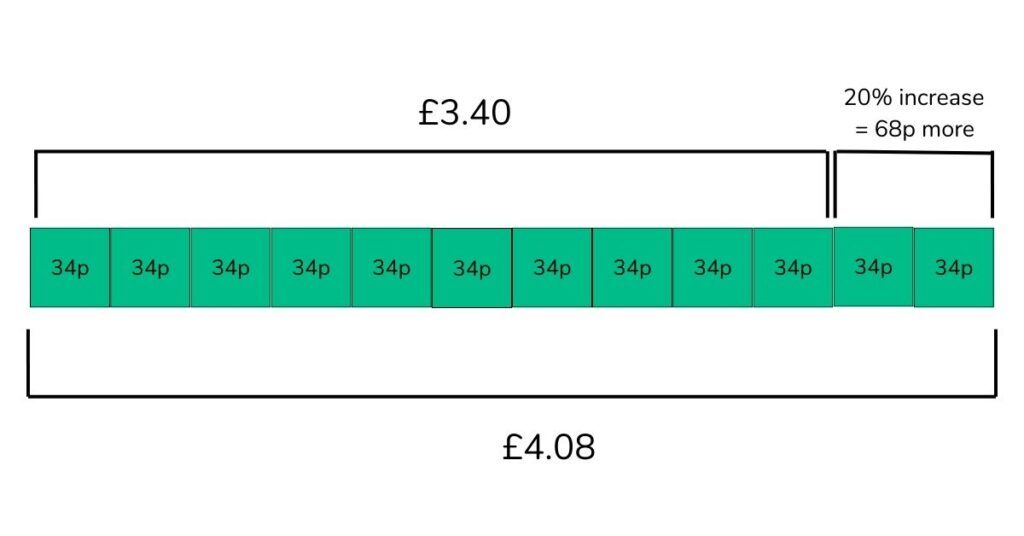
- We can draw a bar model to represent what 10% of £3.40 equals.
- Once we know what 10% of £3.40 is (34p), we can double it to calculate 20% of £3.40 (68p).
- We can then add this on to the original price of £3.40.
- £3.40 + 68p = £4.08.
Percentage word problems for Year 5
To solve word problems for year 5, children need to be able to convert fractions to percentages and calculate fractions of an amount.
Question 1
Gemma saves \frac{1}{2} of her pocket money every week.
She receives £5 per week and is saving to buy a game costing £25.
- What percentage does she save each week?
- How long will it take her to save for the game?
Answer:
- She saves 50% of her pocket money each week
- 10 weeks
Gemma saves £2.50 per week.
£2.50 x 10 = £25
Question 2
Sam gives \frac{4}{10} of his sweets to Ahmed.
What percentage of the sweets does he keep for himself?
Answer: 60%
\frac{4}{10} = \frac{40}{100} = 40%
100 – 40 = 60%
Question 3
A school football team has 11 players and 5 substitutes.
\frac{3}{4} of the players are boys, the rest are girls.
What percentage are girls?
Answer: 25%
\frac{3}{4} of 16 are boys
\frac{1}{4} are girls
\frac{1}{4} = 25%
Question 4
Children in Year 5 voted on their favourite food.
35% of children voted for pizza.
60 children took part in the survey.
How many voted for pizza?
Answer: 21 children
10% of 60: 60 ÷ 10 = 6
5% of 60: Half of 10% (6) = 3
30%: 6 x 3 = 18
35% = 18 + 3 = 21
Question 5
Ben was given a maths worksheet to complete for his homework.
He got \frac{6}{10} of the maths problems correct
If there were 20 questions on the paper:
- How many questions did he get right?
- What percentage did he score?
Answer:
- 12 correct
\frac{1}{10} of 20 = 2
\frac{6}{10} of 20 = 12
- 60% correct
\frac{12}{20} = \frac{60}{100}.
Question 6
An ice cream seller has been researching the most popular ice creams.
He knows the percentage of each flavour of ice cream sold, but wants to work out how many of each flavour were sold.
80 ice creams were sold in total.
40% vanilla
25% strawberry
20% cookie dough
15% mint choc chip
How many of each ice cream flavour were sold?
Answer:
32 vanilla
20 strawberry
16 cookie dough
12 mint choc chip
10% of 80 = 8 ice creams
5% of 80 = 4 ice creams
Vanilla: 4 x 8 = 32
Strawberry: 2 x 8 = 16. 16 + 4 = 20
Cookie dough: 2 x 8 = 16
Mint choc chip: 8 + 4 = 12
Question 7
Pupils in Year 5 held a vote on where to go for their next school trip.
The vote was between the zoo and the aquarium.
90 children voted.
40% voted for the zoo
How many pupils voted for the aquarium?
Answer: 54 children
60% voted for the aquarium
10% of 90 = 9 children
60% = 6 x 9 = 54 children
Question 8
The price of burgers being sold by a burger van have increased by 25%
If the original price was £2 per burger. How much are the burgers now?
Answer: £2.50
25% of £2 = £2 ÷ 4 = 50p
£2 + 50p = £2.50
Percentage word problems for year 6
Word problems for year 6 involve solving problems involving equivalence between fractions, decimals and percentages; calculation of percentages and using percentages for comparison. Year 6 students will also tackle multi-step problems.
Question 1
A rugby game lasts for 80 minutes.
A player is on the pitch for 85% of the game.
How long is he on the pitch for?
Answer: 68 minutes
10% of 80 = 8 minutes
5% = Half of 8 minutes = 4 minutes
80% = 8 x 8 = 64 minutes
64 + 4 = 68 minutes
Question 2
There are 480 pupils in a primary school.
15% in foundation
25% in Key Stage 1
How many pupils are in Key Stage 2?
Answer: 288 pupils
In foundation there are 15% + 25% (40% of the pupils)
Therefore, 60% of pupils are in KS2
10% of 480 = 48 pupils
60% = 6 x 48 = 288 pupils
Question 3
A pizza restaurant decided to add a 15% increase to the cost of all their pizzas.
The cost of a meat feast pizza before the increase was £12.60
What is the new price of the pizza?
Answer: £14.49
10% of £12.60 = £1.26
5% = Half of £1.26 = £0.63
15% = £1.26 + £0.63 = £1.89
New price: £12.60 + £1.89 = £14.49
Question 4
Oliver was shopping for a new pair of jeans.
The jeans were 15% off in the sale, but the new sale price sticker had fallen off.
The original price of the jeans was £35.
How much did they cost in the sale?
Answer: £29.75
10% of £35 = £3.50
5% = Half of £3.50 = £1.75
35% = £3.50 + £1.75 = £5.25
New price: £35 – £5.25 = £29.75
Question 5
200g of sugar is needed for a chocolate brownies recipe.
A 1kg bag of sugar is used.
25% of the remaining sugar is used to bake a cake too.
How much sugar was used to bake the cake?
Answer: 200g sugar
200g sugar used for brownies, therefore 1000g – 200g = 800g remaining
25% of 800g = 800 ÷ 4 = 200g
Question 6
Mr Jones bought a second hand car for £12,400
A year later, it had decreased in value by 15%
What was the value of the car after a year?
Answer: £10,540
10% of 12,400 = £1,240
5% = half of £1240 = £620
15% = 1240 + 620 = £1,860
Value after a year = 12,400 – 1860 = £10,540
Question 7
The number of visitors to a theme park in 2021 was 286,000.
The following year, there was a 24 percent increase in visitors.
How many visited the theme park in 2022?
Answer: 354,640 visitors
10% of 286,000 = 28,600
20% = 2 x 28,600 = 57,200
1% of 286,000 = 2,860
4% = 4 x 2860 = 11,440
24% = 57,200 + 11,440 = 68.640
Total number of visitors: 286,000 + 68,640 = 354,640
Question 8
A library has 16,200 books
55% are fiction and 45% are non-fiction
968 non-fiction books are taken out in one week.
How many non-fiction books are left in the library, from the books which were there at the start of the week?
Answer: 6,322 non-fiction books
10% of 16,200 = 1,620
40% = 1,620 x 4 = 6,480 books
5% = half of 1,620 = 810
45% = 6,480 + 810 = 7,290
7,290 – 968 = 6,322
Percentage word problems for Key Stage 3
In Key Stage 3, the work pupils carry out on percentages, builds upon the percentage skills developed in primary. Students need to be able to solve percent word problems involving interpreting percentages and percentage change as a fraction or decimal; expressing one quantity as a percentage of another; comparing two quantities using percentages; working with percentages greater than 100% and interpreting fractions and percentages as operators.
Question 1
Jasmine wins £600
She gives 30% to her sister and 20% to her friend.
She keeps the rest.
How much does each person have?
Answer:
Sister: £180
Friend: £120
Jasmine: £300
She gives 30% to her sister.
10% of £600 = £60
30% = 3 x 60 = £180
She gives 20% to her friend.
20% = 2 x 60 = £120
She must keep 50% for herself, if she has given 30% and 40% away.
50% of 600 = \frac{1}{2} of 600 = £300
Question 2
A car is reduced in the sale by 15%
If the original price was £18,500, what is the price of the car now?
Answer: £16,225
10% of 18500 = 1,850
5% = half of 1,850 = £925
15% = 1,850 + 925 = £2,275
New price: 18,500 – 2,275 = £16,225
Question 3
Sales tax in Florida is 6%
Maisie has bought a pair of jeans, 3 T shirts and a jacket, which came to $150
How much will she have to pay, once she has added on the sales tax?
Answer: $159
1% of 150 = 1.5
6% = 6 x 1.5 = $9
150 + 9 = $159
Question 4
A packet of biscuits is 300g
As a special offer, the biscuits currently have an extra 15% free.
How many grams of biscuit do you get with the special offer?
Answer: 345g
10% of 300 = 30g
5% = half of 30 = 15g
15% = 30 + 15 = 45g
New weight: 300 + 45 = 345g
Question 5
Jason is travelling to Birmingham from Manchester.
His average speed is 62 miles per hour
On the return journey, the traffic on the M6 is terrible and his average speed it reduced by 35%
What is his average speed on the return journey?
Answer: 40.3mph
10% of 62 = 6.2mph
30% = 6.2 x 3 = 18.6mph
5% = half of 6.2 = 3.1mph
35% = 18.6 + 3.1 = 21.7mph
62 – 21.7 = 40.3 mph
Question 6
Mr Andrews bought a car in January 2021 for £15000.
By January 2022 his car had depreciated in value by 20%.
By January 2023, his car had depreciated in value by another 30%.
What was the value of his car in January 2023?
Answer: £8400
January 2022
20% of £15000 = £3000, so the value of the car is £12000.
January 2023
30% of £12000 = £3600, so the value of the car is £8400.
Alternative method – using decimal multiplier
20% decrease means 80% of January 2021 value – decimal multiplier of 0.8
30% decrease means 70% of January 2022 value – decimal multiplier of 0.7
15000 x 0.8 x 0.7 = £8400.
Question 7
In her half term test, Jasmine did a French test and scored 15 out of 30.
In her next half term test, Jasmine scored 21 out of 30 in her French test.
By what percentage did Jasmine improve?
Answer: 40% improvement
Percentage change
= 21 – 15/15 x 100
= 6/15 x 100 = 40% improvement.
Question 8
In 2021, a company made a profit of $600000.
In 2022, the same company made a profit of $1350000.
By what percentage had their profit increased?
Answer: 125% improvement
Percentage change
= 1350000 – 600000/600000 x 100
= 750000/600000 x 100 = 125% improvement.
Question 9
In 2022, Thomas earned £1800 a month for his job.
As part of his annual review in February 2023, he is going to ask for a pay rise of 3.5%.
If the pay rise is agreed, what will Thomas’ annual salary be?
Answer: £22356
3.5% of £1800 = £63
So new monthly salary would be £1863
£1863 x 12 = £22356.
Alternative method 1
£1800 x 12 = £21600
3.5% of £21600 = £756
£21600 + £756 = £22356.
More word problems resources
Looking for more word problems practice questions? Take a look at our collection of addition and subtraction word problems, time word problems, money word problems and ratio word problems.
Teaching percentages to KS3 or KS4? Check out our percentage worksheets here.
Percentage word problems FAQs
There are different types of percentage problems. If you want to find the percentage of an amount, it can be calculated by writing the percentage as a decimal or a fraction and then multiplying it by the amount.
Pupils in Year 5 held a vote on where to go for their next school trip.
The vote was between the zoo and the aquarium.
90 children voted.
40% voted for the zoo
How many pupils voted for the aquarium?
1. Calculating a discount when shopping
2. Understanding bank interest rates
3. Understanding your grades in school
DO YOU HAVE STUDENTS WHO NEED MORE SUPPORT IN MATHS?
Skye – our AI maths tutor built by teachers – gives students personalised one-to-one lessons that address learning gaps and build confidence.
Since 2013 we’ve taught over 2 million hours of maths lessons to more than 170,000 students to help them become fluent, able mathematicians.
Explore our AI maths tutoring or find out about a primary school maths tutor for your school.



